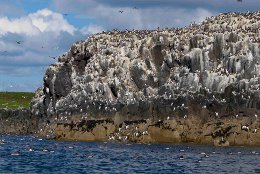A magazine where the digital world meets the real world.
On the web
- Home
- Browse by date
- Browse by topic
- Enter the maze
- Follow our blog
- Follow us on Twitter
- Resources for teachers
- Subscribe
In print
What is cs4fn?
- About us
- Contact us
- Partners
- Privacy and cookies
- Copyright and contributions
- Links to other fun sites
- Complete our questionnaire, give us feedback
Search:
The Tale of the Stormy Petrel

Biology and Computer Science can meet in some unexpected, not to mention inhospitable, places. Who would have thought that the chemical soup in the nests of Stormy Petrels studied by Field Biologists might help in the development of futuristic computer technologies at Intel, for example?
Just Keep Doubling
One of the most successful predictions in Computer Science was made by Gordon Moore, co-founder of Intel. Back in 1965 he suggested that the number of transistors that can be squeezed onto an integrated circuit - the hardware computer processors are made of - doubled every few years: computers get ever more powerful and ever smaller. In the 40 or so years since Moore's paper it has remained an amazingly accurate prediction. Will it continue to hold though or are we reaching some fundamental limit? Researchers at Intel are confident that Moore's Law can be relied on for the foreseeable future. The challenge will be met by the material scientists, the physicists and the chemists. Computer scientists must then be ready for the Law's challenge too: delivering the software advances so that its trends are translated into changes in our everyday lives. It will lead to ever more complex systems on a single chip and so ever smaller computers that will truly disappear into the environment.
Dusting computers
Motes are one technology under development on the back of this trend. They are dust-sized computers. Scatter them around the environment and they form unobservable webs of intelligent sensors. Scatter them on a battlefield to detect troop movements or on roads to monitor traffic flow. Mix them in concrete and monitor the state of a bridge. Embed them in the home to support the elderly or in toys to interact with the kids.
What barriers must be overcome to make motes a ubiquitous reality? Much of the area of a computer is taken up by its connections to the outside world - all those pins allowing things to be plugged in. They will be replaced by wireless communications. At the moment computers contain multiple chips each housing separate processors. It is not the transistors that are the problem but the packaging - the chip casings are both bulky and expensive. The future is for what is known as "multicore" chips: large numbers of processors on a single small chip courtesy of Moore's Law. This will lead to significant challenges to Computer Scientists over how to develop the software to run on such complicated hardware. Battery technology is the only big problem that remains. Motes will soon be with us.
Enter the Petrels
But how do you test a device like that? Enter the Stormy Petrels. Intel's approach is not to test futuristic technology on average users but to look for extreme ones who believe a technology will deliver them massive benefits. In the case of Motes, the extreme users are field biologists who want to keep tabs on birds in extremely harsh field conditions. Not only is it physically difficult for humans to observe sea birds' nests on inhospitable cliffs but human presence disturbs the birds. The solution: scatter motes in the nests to detect heat, humidity and the like from which the state and behaviour of the birds can be deduced. A nest is an extremely harsh environment for a computer though, both physically and chemically. A whole bunch of significant problems, overlooked by normal lab testing, must be overcome. The challenge of deploying Motes in such a harsh environment has led to major improvements in the technology.
Moore's Law is with us for a while yet, and with the efforts of material scientists, physicists, chemists, computer scientists and even field biologists and their sea birds it will continue to revolutionise our lives.


